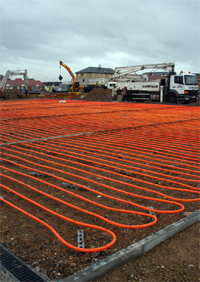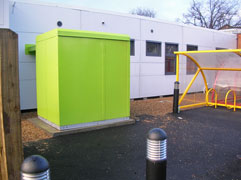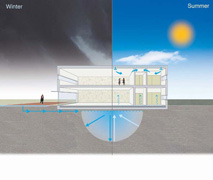Ground Source Heating and Cooling
Ground Source Heating and Cooling ("GSHC") is the term used to describe a single integrated system that performs both heating and cooling using the same equipment linked to ground source energy: joined-up heating.
A critical component of a successful GSHC installation is to have the control philosophy embedded into the heart of the system. In an ICAX IHT system this allows for simultaneous heating in one part of a building (such as north facing low-activity room) and cooling in another (IT server rooms). This technique results in the cheapest form of heating and the cheapest form of cooling – both in cash terms and in CO2 emissions.
Ground Source Heating and Cooling systems use Thermal Energy Storage
Ground source heating and cooling systems take advantage of the Thermal Energy Storage capacity of the ground to heat buildings in winter and cool buildings in summer.
GSHC systems employ Renewable Heating in winter and Renewable Cooling in summer.
Ground source energy is a renewable source of energy which can be used for heating buildings. Architects, consultants and building owners have realised that ground source energy can be exploited the whole year around to provide significant reductions in carbon dioxide emissions and heating and cooling costs.
Heat can be extracted via fluid circulating through an array of pipes in the ground to provide heating to buildings in winter. The ground acts as a "heat source". The ground can also be used as a "heat sink" for heat extracted from a building in summer in order to provide cooling. For the ground to be used as a ThermalBank in this way it is necessary to ensure that there is a balance of heat extracted and heat deposited in the ground over the course of the year. This enables Heat Recycling – the essence of Renewable Energy.
Thermal Modelling of the complete system is necessary to ensure that this balance is achieved in a sustainable way over the years. If heat is extracted for space heating purposes without any heat being deposited (from cooling the building in summer) there is a risk that the ground temperature will fall each year and the heat pump will cease to be efficient – it may even "lock up". The solution is to collect solar energy in the summer and transfer heat to the ground in advance of the heating season: this is the essence of Interseasonal Heat Transfer and enables the heat pumps in an ICAX Skid to extract heat more cheaply and more efficiently than in an unassisted heat pump installation.
Heat collection for Ground Source Heating and Cooling
Surplus solar energy can be collected in summer to boost ground source energy in winter by using Asphalt Solar Collectors or standard solar thermal collectors to provide solar recharge of the ground. Surplus heat can also be released from buildings in summer using Natural Cooling. The most effective combination is found in Interseasonal Heat Transfer which utilises ground source heating and cooling in one integrated system: Solar Assisted Ground Source Energy.

Heat storage for Ground Source Heating and Cooling
Surplus solar energy can be stored in summer in Thermalbanks to boost the ground source energy available in winter and double the coefficient of performance of ground source heat pumps: Underground Thermal Energy Storage.
Heat distribution from Ground Source Heating and Cooling
Having extracted heat from the ground using a heat pump, there are various different mechanisms for distributing heat within a building. Because a heat pump is most efficient when delivering warmth – at around 40°C – instead of heat – at around 70°C, it is best to use a distribution system that matches these lower output temperatures. Underfloor heating is ideal, but other options like TermoDeck and VRF fan coil units can also be very effective, as can direct supply to air handling systems.
Ground Source Cooling
Ground source cooling can be used to cool buildings. This approach is less expensive than air conditioning which provides cooling by heat exchange with external air – often hot air. Ground source cooling is a mechanism of allowing the excess heat within a building to escape to cold ground. This natural process is cheaper than using electricity to force heat out into hot air. The process of releasing heat to the ground also provides the useful function of heating the ground in preparation for using ground source energy the following winter to return the heat to the building from which it came: joined-up heating.

Ground Source Heating and Cooling – GSHC – Joined-up Heating
A well designed IHT system can achieve substantial reductions in running costs, energy use and green house gas production compared to gas based heating and chiller based cooling. ICAX combines expertise in thermal modelling and experience in installing GSHC systems to guarantee reliable and sustainable integrated systems with a high co-efficient of performance in winter heating and summer cooling in a well balanced system. The low annual running cost of IHT systems is further reduced to a nominal figure for non-domestic buildings by the introduction of the Renewable Heat Incentive.
In search of balance using GSHC
ICAX provides Interseasonal Heat Transfer ("IHT") which performs all the functions of a GSHC installation. IHT can help you achieve a heat balance within a building: IHT can extract heat from fileserver rooms and those suffering from solar gain and distribute it to shaded rooms needing heat. This saves on heating cost for cold rooms and cooling cost for hot rooms. When there is an overall cooling requirement IHT will save the excess heat from the building in a ThermalBank – and recycle that heat back to the building in winter. For buildings with an overall annual cooling requirement, ICAX uses heat rejection techniques (at night time and in winter) to dissipate surplus heat.
Integration and Harmony
IHT is a straightforward ground source heating and cooling system that is designed to balance the heating and cooling requirement of a building over the course of the seasons. This is in contrast to the traditional approach of throwing money and fossil fuels indiscriminately at both extremes of the year, as if they were separate problems that had to be addressed by separate budgets and separate mechanisms.
District Heating and Cooling
The mechanism of ground source heating and cooling can be extended to district heating and cooling: there are advantages in adjacent buildings sharing a ground array. If one building needs cooling at the same time as another needs heating it can be advantageous to both to share the same borehole field and participate in Heat Sharing.
GSHC is used on the following ICAX Projects
Merton Intergenerational Community Centre
| Tesco Greenfield Superstore
| Cambridge Terrace
| UTP Factory
See also: Renewable Heating
See also: Banking on IHT™
See also: article on Natural Cooling
In the context of UK climate change targets, the Environmental Agency "encourages GSHC systems that are well-managed and designed to present a low risk to the environment."



